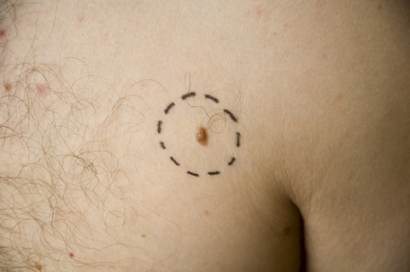Malignant Melanoma Skin Cancer
is Preventable
Sun Protection is a fact of life™
When you hear the words malignant melanoma skin cancer, you will most probably be afraid. All you will hear are the words "malignant" and "cancer" repeating over and over again in your shocked mind.
After all, cancer happens to other people, not to you! Or your family and friends, if you have any say it, which you do have provided that you can take the necessary sun protection measures.
And that is where you should have acted before you even heard the doctor's diagnosis of malignant melanoma skin cancer.
What is melanoma?
Melanoma is the least common of all skin cancers at just a 5 percent incidence rate but it is the riskiest form. Melanoma is so named because it develops in the melanin cells, which provide the skin its color.
It can develop anywhere in your body from your face to your feet regardless if the area receives little to no sun.
What should you beware of?
Fortunately, melanoma announces itself, in a manner of speaking, although you have to be vigilant in looking for the signs especially if you are a lover of sun, sand and sea.
Most often, you will observe changes on a mole as well as the development of new growths in your skin.
You may also use the so-called ABCDE of malignant melanoma skin cancer: asymmetry, border, color, diameter and evolving.
Usually, skin moles and growths have uneven borders, varying shades, larger diameters and are noticeably evolving in color, size and shape.
What could have been done?
Although there are risk factors that you have no control whatsoever like family history, age and skin type, you have complete control over your sun exposure, sun protection, diet and vitamin D intake as well as environmental contact.
Act on what you can control instead of becoming obsessed with what is beyond your powers.
Start with avoiding the sun when its rays are at their strongest, which is usually around 10 a.m. to 4 p.m. - give or take 30 minutes depending on where you live.
And if you must go out into the sun during these hours, then apply organic sunscreen all over your face and body preferably one with SPF 15 and do so thirty minutes before actual sun exposure.
Then move on into wearing clothing and personal accessories with sun protection in them. You can find manufacturers of these clothing items that literally add another layer of uv protection.
You should also avoid environmental stimuli like spending any amount of time in tanning beds, exposing yourself to harmful chemicals and even taking medications that affects sensitivity to the sun.
Ask your doctor about these risk factors so that you are better able to avoid them.
Lastly, it has been proven that a diet rich in fruits and vegetables, whole grains and cereals as well as other vitamin D-enriched foods are effective in lessening your skin cancer risks.
You will enjoy the health benefits of such a healthy diet through a better immune system.
Malignant melanoma skin cancer is a complex interplay of ultraviolet radiation, sun protection behavior and risk awareness as well as early diagnosis and treatment. Focus on what you can control in such a complex interplay and be rewarded with healthy skin free from malignant melanoma.









New! Comments
Have your say about what you just read! Leave me a comment in the box below.